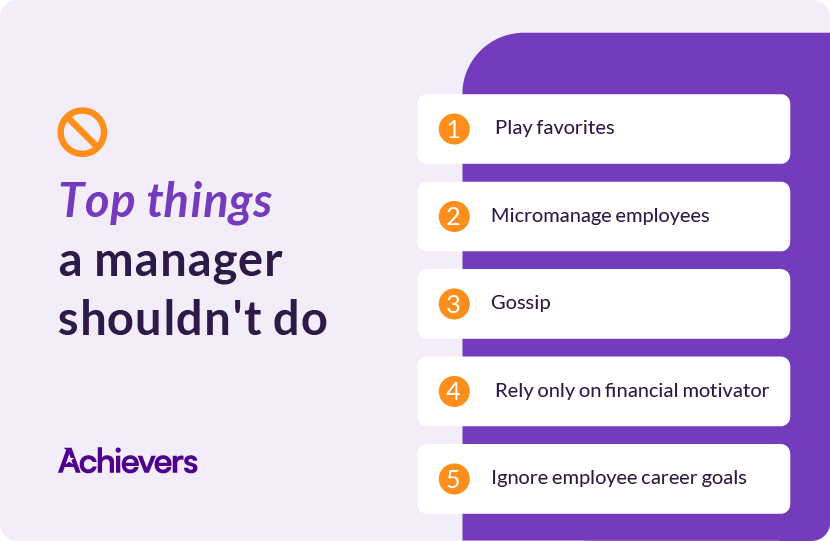Table of contents
Retaining top talent is a challenge for many organizations. So, how do you solve this at your company? A good place to start is with management. With 65% of employees considering leaving their jobs in 2024 alone, only 8% cite their relationship with their manager as the primary reason for staying with a company. This shows there’s ample room for improvement in manager-employee relations across the board.
By focusing on improving management practices, companies can address broader issues that impact employee satisfaction and retention. Strengthening the role of management can create a ripple effect, leading to higher employee engagement and retention rates.
To avoid losing valuable talent due to poor management practices, we’ve put together a list of the top 10 things that good leaders should never do — and some solutions to the problems — if they want to keep their employees happy, engaged, and committed to their workplace.

10 things managers should never do
1. Play favorites
Creating a fair and inclusive workplace where every employee feels valued and motivated is crucial for any employer aiming for long-term success. Favoritism, however, can quickly undermine this goal, leading to a myriad of issues that can cripple an organization from within.
Firstly, favoritism leads to decreased morale and motivation. Employees who feel undervalued are less likely to be productive and engaged, which can severely impact overall performance. These disgruntled employees often seek opportunities elsewhere, increasing turnover rates and the associated costs of hiring and training new staff.
Trust is another casualty of favoritism. When employees perceive that management plays favorites, trust in leadership and among colleagues diminishes. This erosion of trust hampers collaboration and communication, essential elements for a cohesive and effective team.
One critical aspect of avoiding favoritism is avoiding pitting generations of workers against each other. Encouraging intergenerational conflict not only exacerbates stereotypes but also alienates both younger and older employees. This division weakens team cohesion, stifles motivation, and curtails creativity, ultimately hindering overall performance and innovation.
How to correct the behavior
- Establish clear criteria: Create transparent guidelines and criteria for promotions, rewards, and recognition. Ensure that these criteria are based on objective measures such as performance, skills, and contribution to the organization rather than personal preferences or relationships.
- Implement fair processes: Ensure that all employees have equal access to opportunities for advancement and recognition. Implement fair processes such as blind reviews for promotions or rotating assignments to prevent managers from consistently favoring certain individuals.
- Provide training and awareness: Offer training programs for managers and employees to raise awareness about the negative impacts of favoritism and how to prevent it. Encourage open communication channels where employees can report instances of favoritism without fear of retaliation and take prompt action to address any complaints.
2. Rely only on financial motivators
Employees want more than just a paycheck; they crave opportunities to learn, grow, and feel like valued members of a successful team. In fact, a surprising statistic from Achievers Workforce Institute (AWI) shows that 72% of employees would stay longer at a job where they feel supported, cared for, and valued, even if another job offered 30% more pay. This underscores the critical importance of mentorship, training programs, and a positive company culture in fostering employee retention and satisfaction. When employees feel appreciated and empowered to grow, they’re more likely to stay committed and contribute to the organization’s success.
Focusing too much on money can have its drawbacks. Financial motivators often shift attention away from long-term goals, leading to a short-term focus that can be detrimental. Overemphasis on money can also reduce intrinsic motivation, making employees less passionate about their work. Additionally, the pressure to meet financial targets may lead to unethical behavior, further damaging the workplace environment. Individual incentives can hinder teamwork and collaboration, while a sole focus on financial rewards can stifle innovation and creativity.
How to correct the behavior
- Foster intrinsic motivation: Connect roles to company mission and values, emphasizing purpose beyond financial rewards. Provide growth opportunities through training and mentorship to enhance personal and professional development.
- Promote recognition and appreciation: Implement structured recognition programs that celebrate both individual and team achievements. Foster a culture where regular appreciation among colleagues reduces dependence on financial incentives.
- Encourage collaboration and teamwork: Set collaborative goals that emphasize collective success over individual financial targets. Organize team-building activities to strengthen bonds among employees, fostering motivation through team achievements.
3. Gossip
Encouraging gossip in the workplace can create many negative consequences that undermine team dynamics and individual well-being. Gossip spreads misinformation like wildfire, leading to misunderstandings and eroding trust among colleagues. This can fracture teamwork, as employees become more focused on rumors than on working collaboratively towards shared goals.
Gossip often fosters a toxic environment where morale dips and productivity suffers. It can tarnish reputations unfairly and even escalate into conflicts that distract from the core mission of the organization. From a managerial perspective, promoting a culture that discourages gossip not only preserves professionalism but also cultivates a positive atmosphere where open communication and mutual respect thrive.
How to correct the behavior
- Establish clear communication channels: Encourage open and transparent communication across all levels of the organization. Provide regular updates and hold team meetings where employees can ask questions and express concerns. When employees have accurate information and feel heard, the need for gossip diminishes.
- Promote a positive workplace culture: Foster a culture of respect, trust, and support. Implement team-building activities and workshops that emphasize collaboration and mutual respect. Recognize and reward positive behavior and discourage negativity and rumor-spreading. A strong, positive culture can reduce the desire to engage in gossip.
- Implement and enforce a no-gossip policy: Develop a clear policy that outlines the harmful effects of gossip and the consequences of engaging in it. Provide training on how to handle gossip and create an environment where employees feel comfortable reporting concerns without fear of retaliation. Consistently enforce the policy to show that the organization takes it seriously.
4. Criticize or publicly humiliate employees
Criticism and humiliation from managers can have far-reaching negative effects on both individuals and the overall workplace environment. When managers publicly criticize or humiliate employees, it not only damages their self-esteem but also undermines their confidence and motivation. This can lead to decreased productivity and a reluctance to contribute ideas or take initiative, as employees may fear further embarrassment.
Such behavior erodes trust and respect within the team. When employees feel humiliated or unfairly criticized, it creates a culture of fear rather than cooperation. Communication breaks down, teamwork suffers, and the overall atmosphere becomes tense and unproductive.
From a broader perspective, frequent criticism and humiliation can contribute to high turnover rates as talented employees seek more supportive work environments. It also tarnishes the organization’s reputation, as word spreads about the manager’s detrimental behavior.
How to correct the behavior
- Promote constructive feedback culture: Encourage managers to provide feedback in a private setting, focusing on specific behaviors or outcomes rather than personal attributes. Train managers on effective communication techniques that emphasize respect and empathy.
- Implement training and development programs: Offer leadership training programs that emphasize positive management practices, including how to deliver feedback effectively and foster a supportive work environment. Include modules on conflict resolution and emotional intelligence.
- Establish clear policies and guidelines: Develop and communicate clear policies that prohibit public criticism and humiliation of employees. Ensure all managers understand the consequences of such behavior and provide avenues for employees to report concerns confidentially. Regularly review and reinforce these policies to uphold a respectful workplace culture.
5. Ignore employee turnover rates
It’s no secret that every company deals with turnover, but some companies see higher numbers of departures than others. For example, a Mercer report states that the average voluntary turnover rate in the U.S. is 17.3%. If your turnover rate is higher than this, you may have a problem that needs addressing.
Ignoring high turnover rates can deeply impact a workplace. Frequent turnover disrupts team dynamics and reduces continuity, making it challenging to maintain stable working relationships and efficient collaboration. This not only hampers productivity but also lowers morale among the remaining staff, who may feel unsettled by constant changes.
Financially, high turnover imposes substantial costs through recruiting, onboarding, and training new employees, draining resources that could be invested in growth. Moreover, it diverts attention from strategic initiatives, further affecting the company’s bottom line.
Beyond financial implications, persistent turnover can tarnish the organization’s reputation. Potential candidates may see it as a sign of instability, complicating recruitment efforts and making it harder to attract top talent. Among current employees, high turnover can breed skepticism and erode trust in leadership, decreasing overall loyalty and engagement.
How to correct the behavior
- Conduct exit interviews and feedback analysis: Regularly conduct exit interviews to understand the reasons behind employee departures. Analyze feedback to identify recurring issues or trends contributing to turnover. Use this information to implement targeted improvements in areas such as workplace culture, leadership, compensation, or career development opportunities.
- Enhance employee engagement and satisfaction: Focus on improving employee engagement through initiatives that foster a positive work environment. Offer opportunities for professional growth and development, provide regular feedback and recognition for achievements, and ensure fair and competitive compensation and benefits. Engaged employees are more likely to feel valued and motivated to stay with the company.
- Implement retention strategies and programs: Develop and implement retention strategies tailored to address specific causes of turnover identified through feedback and analysis. This could include mentoring programs, flexible work arrangements, wellness initiatives, or improving communication channels within the organization.
6. Take credit for their employees’ efforts
Some managers have a habit of monopolizing credit for successes, disregarding the collaborative efforts that contribute to achievements. This self-centered behavior can have significant negative impacts on team dynamics and overall morale. When managers fail to acknowledge the collective contributions of team members, it fosters resentment and division within the team. Employees may feel undervalued and demotivated, leading to a decline in productivity and a lack of commitment to organizational goals.
Beyond celebrating successes, effective leadership entails taking responsibility for failures. Managers who refuse to own up to mistakes or shift blame onto others undermine trust and cohesion among team members. This behavior creates a culture of fear and mistrust, where individuals are hesitant to take risks or admit their own shortcomings. It stifles open communication and collaboration, hindering the team’s ability to learn from mistakes and improve together.
Additionally, the practice of not giving credit where it’s due further exacerbates the negative impact. When managers consistently fail to recognize and appreciate the efforts of their team members, it erodes morale and diminishes motivation. Employees may feel undervalued and unappreciated, leading to higher turnover rates and difficulty in retaining top talent. This lack of recognition can also contribute to a toxic work environment characterized by resentment and disengagement.
How to correct the behavior
- Promote team recognition efforts: Encourage a culture where successes are celebrated as team achievements rather than individual feats. Implement regular team meetings or newsletters that highlight contributions from all team members involved in successful projects. This shift reinforces the importance of collaboration and ensures that everyone receives recognition for their efforts.
- Lead by example: Model humility and transparency by publicly acknowledging the contributions of team members in meetings, emails, or company-wide communications. When managers consistently give credit where it’s due, it sets a positive example for others to follow and reinforces a culture of mutual respect and appreciation.
- Establish clear communication expectations: Set clear expectations regarding communication and recognition within the team. Encourage open dialogue where team members are encouraged to share their achievements and contributions. Ensure that credit is attributed accurately and fairly, emphasizing the value of each team member’s role in achieving success.
7. Expect people to do the impossible
A Stanford study found that productivity declines sharply when someone works more than 50 hours per week. Giving someone an unreasonable deadline is a setup for failure.
When employees face impossible expectations, several negative consequences unfold. Firstly, morale suffers as individuals feel overwhelmed and unable to meet the demands placed upon them. This can lead to increased stress, burnout, and even physical health issues among employees striving to meet unrealistic goals. Productivity also declines as individuals struggle to prioritize tasks effectively under immense pressure, resulting in rushed work, errors, and diminished quality.
From a team perspective, setting unattainable expectations can erode collaboration and trust. Team members may feel unsupported by management or resentful towards colleagues perceived as contributing to an unmanageable workload. This can create a toxic atmosphere where communication breaks down and morale continues to plummet.
Additionally, the long-term effects on organizational culture are profound. Continual exposure to impossible expectations can lead to high turnover rates as employees seek more reasonable work environments where their efforts are valued, and achievable goals are set. This turnover not only disrupts continuity and knowledge retention within the organization but also damages its reputation as an employer of choice.
How to correct the behavior
- Establish realistic goal setting: Encourage managers to collaborate with their teams to set realistic and achievable goals. This involves assessing project scope, available resources, and timelines realistically. Provide training or workshops on effective goal-setting techniques that prioritize quality and sustainability over unrealistic demands.
- Promote open communication: Foster a culture where employees feel comfortable discussing workload and deadlines openly. Encourage managers to regularly check in with their teams to assess progress and identify potential challenges early on. Create a feedback loop where employees can provide input on goal-setting processes to ensure alignment with capabilities and resources.
- Provide support and resources: Equip managers with the tools and resources necessary to support their teams in achieving goals. This may include additional training, staffing adjustments, or technological solutions that streamline workflows. Empower managers to advocate for their teams’ needs and collaborate cross-functionally to prioritize realistic expectations across departments.
8. Micromanage employees
Micromanaging is an outward sign of distrust and a relationship issue. It discourages teamwork and open communication. Good managers challenge employees to be innovative and give them the right tools to succeed.
When managers excessively control every aspect of their team’s work, they inadvertently stifle creativity and innovation. Employees may feel hesitant to propose new ideas or solutions, fearing scrutiny or rejection. Beyond this, micromanagement also undermines morale and motivation. Constant oversight erodes trust and autonomy, leaving employees feeling disempowered and undervalued. Instead of feeling inspired to excel, they may become disengaged, affecting overall productivity and job satisfaction.
Operationally, micromanagement can lead to inefficiencies. Employees may spend more time seeking approval or following detailed instructions rather than focusing on completing tasks efficiently. This can result in missed deadlines and increased stress, impacting team dynamics and collaborative efforts.
The relational fallout of micromanagement is significant. It strains communication and trust between managers and their teams, hindering effective collaboration. When employees perceive their contributions as undervalued or micromanaged, it can lead to dissatisfaction and potentially higher turnover rates.
How to correct the behavior
- Promote empowerment and trust: Encourage managers to empower their teams by delegating tasks and responsibilities effectively. Establish clear goals and expectations but allow flexibility in how tasks are accomplished. Trusting employees to make decisions and take ownership of their work fosters a sense of autonomy and accountability.
- Encourage open communication: Foster a culture of open communication where feedback flows freely between managers and their teams. Encourage regular check-ins that focus on progress and development rather than mere oversight. Create opportunities for employees to voice their ideas, concerns, and challenges, ensuring they feel heard and valued.
- Provide leadership development: Offer training and development programs for managers to enhance their leadership skills, including effective delegation, coaching, and mentoring techniques. Help managers understand the difference between supportive guidance and micromanagement. Equip them with tools to build strong, trusting relationships with their teams based on mutual respect and collaboration.
9. Fail to support others
In any workplace, the impact of failing to support others can be profound, especially regarding employee development and the organization’s overall health. When colleagues and supervisors neglect to offer crucial guidance and encouragement, employees can find themselves at a standstill in their professional growth. This lack of support not only hinders skill development and limits career advancement opportunities but also weakens team cohesion and erodes trust, making it challenging to achieve collective goals effectively.
The absence of support also has direct implications for employee morale and engagement. Feeling undervalued or unsupported by peers and managers can lead to disengagement and a decline in motivation. This negative atmosphere doesn’t just affect individual performance; it permeates through the team, impacting overall productivity and potentially increases turnover rates.
How to correct the behavior
- Promote a culture of collaboration and communication: Encourage open communication and teamwork by fostering an environment where colleagues feel comfortable seeking and offering assistance. Establish regular team meetings or collaboration sessions to discuss challenges and share ideas. Emphasize the importance of mutual support and highlight successful instances of teamwork to reinforce positive behaviors.
- Provide training and development opportunities: Offer training programs that focus on interpersonal skills, empathy, and effective communication. Equip employees and managers with tools to recognize and address the needs of their colleagues. Foster a culture of continuous learning where individuals are encouraged to enhance their ability to support and collaborate with others effectively.
- Lead by example and recognize supportive behavior: Managers should lead by example by actively demonstrating and promoting supportive behaviors. Encourage managers to recognize and celebrate instances where employees go above and beyond to support their colleagues. Implement a formal recognition program that acknowledges teamwork and collaboration, reinforcing the value of supportive actions within the organization.
10. Ignore employee career goals
Ignoring employee career goals in the workplace has far-reaching implications for organizational health. Employees join companies expecting not only to fulfill job descriptions but also to find opportunities for career growth and development, from informal peer discussions to formal training and challenging assignments.
Managers play a critical role as the bridge between employees and these career-building opportunities. When managers neglect to support their team members’ career ambitions, employees may feel undervalued and demotivated, leading to decreased morale and increased turnover rates. This lack of attention to career development can also weaken communication and collaboration within teams, hindering overall effectiveness.
Neglecting career aspirations also stifles innovation and growth potential within the organization, limiting employees’ ability to contribute fully and impacting the company’s competitiveness.
How to correct the behavior
- Regular career development discussions: Implement regular one-on-one meetings between managers and employees specifically focused on career development. Encourage open dialogue about career aspirations, interests, and goals. Managers should actively listen to employees’ ambitions and work together to create actionable plans for achieving them within the organization.
- Provide tailored development opportunities: Offer personalized development opportunities such as training programs, mentorship, stretch assignments, and job rotations. Align these opportunities with employees’ career goals and interests to ensure they are engaged and motivated to pursue growth within the organization.
- Promote a culture of recognition and support: Recognize and celebrate employees’ achievements and milestones related to their career development. Encourage managers and colleagues to provide positive feedback and support for efforts towards career advancement. Foster a culture where employees feel valued and encouraged to pursue their aspirations, contributing to a more motivated and loyal workforce.
How to revitalize workplace culture with engagement and recognition
The common thread linking all ten poor managerial practices is the failure to recognize the critical importance of employee socialization, engagement, and recognition in fostering a thriving workplace culture. When managers neglect these aspects, it creates a ripple effect of disengagement, low morale, and reduced productivity among employees. Socialization builds camaraderie and teamwork, essential for collaboration and achieving collective goals. Engagement ensures that employees are motivated, committed, and aligned with organizational objectives, driving innovation and growth. Recognition acknowledges employees’ contributions and reinforces positive behaviors, enhancing job satisfaction and retention.
Achievers addresses these challenges by providing a structured framework for recognizing and rewarding employee achievements. By facilitating meaningful recognition, we help organizations foster a culture of appreciation where employees feel valued and motivated. This, in turn, strengthens social bonds, boosts engagement levels, and encourages continuous improvement. By leveraging our tools and insights, managers can effectively mitigate the negative impacts of poor managerial practices and cultivate a positive work environment where employees thrive and contribute their best efforts towards organizational success.

Find out what makes an online employee recognition platform effective
Read the 2024 recognition report


